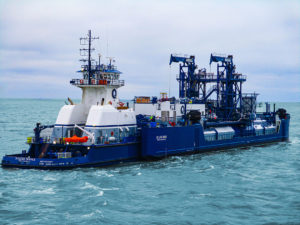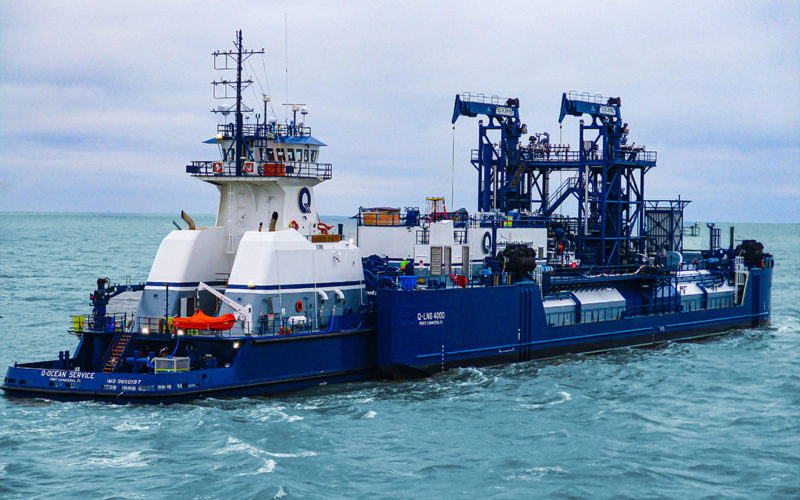
If you want to understand the special role Q-Ocean Service and its liquefied natural gas (LNG) bunkering barge play in the maritime industry, start by imagining a cruise ship.
The massive vessel’s passengers are frolicking on decks, surrounded by the sun and a turquoise sea. Over their heads, giant stacks belch exhaust that can tarnish this idyllic environment.
“People are stepping on, feeling and breathing that black soot all day,” said Shane Guidry, the owner of Q-LNG Transport LLC, which built the first articulated tug-barge (ATB) specifically designed to bunker LNG. “When you convert to liquefied natural gas, that completely goes away because you no longer have black soot and smoke coming out of the smokestacks polluting the air … which is why the cruise ship industry was the first one that turned to it.”
Guidry, also the chairman and CEO of Harvey Gulf, was an early adopter of LNG as a marine fuel. Harvey Gulf in 2015 became the first U.S. maritime company to own and operate an LNG-fueled marine service vessel with the delivery of Harvey Energy. These days, the company has five LNG-powered offshore supply vessels working in the Gulf of Mexico and elsewhere. It also operates an LNG fueling terminal in Port Fourchon, La.
LNG’s place as a cleaner-burning and often lower-cost alternative to heavy marine fuels has attracted the attention of cruise lines and big shippers alike. Most large ships built in the United States and elsewhere are equipped with engines that can run on LNG. As a result, demand for vessels that can deliver LNG fuel has risen sharply over the past five years.
Q-LNG was an early entrant into the market to supply LNG to U.S.- and foreign-flagged ships calling on the southeastern U.S. The 128-foot Q-Ocean Service pairs with the 324-foot Q-LNG 4000, sometimes referred to as Q-4000, through an Articouple pin system. The barge can carry 4,000 cubic meters of ultra-cold liquefied natural gas.
LNG offers some notable emissions advantages over traditional marine diesel — a factor that is increasingly relevant and attractive to ship operators. In round numbers, LNG releases 99 percent less sulfur dioxide, 80 percent less nitrogen oxide and 40 percent less carbon dioxide compared to diesel. LNG exhaust contains no soot particles or heavy metals.
Safety equipment on the barge includes sophisticated gas detection systems, and the tug and barge are each equipped with a fire monitor capable of blasting 2,500 gallons of water per minute. The barge is full of equipment meant to keep the liquefied natural gas cold, including four type-C vacuum-insulated double-walled tanks — each capable of holding 1,000 cubic meters of gas — and a system that keeps the gas in a liquid form at minus 160 degrees Fahrenheit. Wartsila supplied the tanks and the cooling system.
Q-4000 is the first natural gas bunkering vessel built in North America to use a pressurized gas tank containment system, and it’s also the first natural gas bunkering vessel worldwide to be constructed as an ATB, said Adi Aggarwal, director of the Global Gas Solutions team at the American Bureau of Shipping (ABS).
The ATB has a Wartsila dynamic positioning system and is the first in the U.S. to earn the IMO’s DP-1 Plus notation, according to Q-LNG President Chad Verret.
In another first, Verret said, the LNG bunkering ATB supplied fuel to the 820-foot Gagarin Prospect — the world’s first LNG-fueled Aframax crude tanker. Ther ship-to-ship transfer occurred in March near Port Canaveral, Fla.
Q-Ocean Service was designed by Seattle-based Jensen Maritime Consultants, now known as Crowley Engineering Services. Houston-based Waller Marine designed the barge with input from Q-LNG. VT Halter Marine in Pascagoula, Miss., built the ATB, which launched in March 2020 and was delivered in late December 2020.
Building Q-4000 took “a big checkbook,” Guidry said.
“I mean, look, if you went and built a barge that delivered diesel fuel, like the one I just built, it would probably cost you about $60 million,” he said. “To go build one like I built is $100 million.”
Guidry is convinced the ATB will pay off in the long run. The cruise ship industry’s desire to rid its decks of soot isn’t the only factor pushing the shipping industry away from heavy oil, which throws off a large amount of pollution in its exhaust.
“In 2020, that law changed where you can only run ultra-low sulfur diesel fuel,” Guidry said, citing new standards imposed by the International Maritime Organization (IMO). Starting Jan. 1, 2020, the rules reduced the global upper limit on sulfur content in ships’ fuel oil from 3.5 percent to 0.5 percent. Some areas have adopted even stricter limits that put pressure on shipping companies to install “scrubbers” to reduce pollution, or find a new source of fuel — such as LNG.
When it’s not delivering liquefied natural gas to vessels, the ATB is based out of Elba Island, Ga., near Savannah, or at Port Canaveral, which is one of the busiest cruise ports in the world. The cruise ship industry shut down due to COVID-19 but is looking to rebound as more people travel post-pandemic.
Shell has signed a long-term charter for the ATB. Its bunkering customers include two new ships for Carnival Cruise Line and two dual-fuel ships for SIEM Car Carriers that are under charter to Volkswagen for transporting vehicles from Europe to North America.
Q-Ocean Service is 128 feet long by 42 feet wide, with a molded depth of 21 feet. Its accompanying barge is 324 feet by 64 feet. The combined ATB is 378 feet long.
Propulsion comes from twin GE Tier 4 engines delivering 5,100 total hp through Wartsila z-drives. Two 150-kW Cummins QSM11-DM gensets and two 99-kW Cummins QSB7 engines provide electrical and emergency power to the tugboat.
Q-4000 gets power for its complex electrical system from five 450-kW Cummins QSK19-DM engines. Coastal Marine Equipment supplied mooring winches installed fore and aft on both sides of the barge. Wartsila supplied a 1,207-hp bow thruster for enhanced maneuverability in close quarters.
ATBs have increasingly replaced traditional tugboats towing tank barges off the stern. One key reason is the robust connection that allows the ATB to operate in rougher weather without the risk of snapping a towing wire.
ATBs also have an advantage over tankers by having the capability to operate with a much smaller crew. Q-Ocean Service operates with a crew of eight, compared to 17 for a similarly sized ship. That leads to about $7,000 a day in reduced personnel costs, Guidry said.
The first LNG bunker barge purpose-built in North America was Clean Jacksonville, constructed by Conrad Shipyard for TOTE Maritime and launched in 2018. Clean Jacksonville stores liquefied natural gas in a containment system designed by the engineering company GTT. Known as a membrane system, it’s a lining for the ship’s hull that seals the LNG and keeps it cold.
By contrast, Q-4000 has pressurized storage tanks akin to the oversized propane tanks you might find on a grill, said Aggarwal of ABS, which was involved with the Q-LNG project before naval architects had even finished their plans.
The classification society worked with the U.S. Coast Guard on regulatory requirements, took part in the engineering design review and surveyed shipyard construction. ABS will continue to inspect the barge, and more LNG bunkering vessels are expected for delivery in coming years.
“Each vessel is going to be in some ways a more mature version of the previous one,” Aggarwal said.
One major area of development is LNG carrying capacity. With 4,000 cubic meters, Q-4000 holds nearly twice as much LNG as Clean Jacksonville. Q-LNG is exploring building another bunkering ATB that will hold up to 8,000 cubic meters of LNG.
LNG has come a long way in the U.S. and around the world compared to a decade ago. But it hasn’t gained total acceptance in the shipping industry, and the fuel isn’t yet readily available in every port. The transition away from diesel is gaining steam, however.
“What I can tell you is that today, all the new orders that have been placed, they’re either burning LNG fuel or they’re LNG fuel-ready,” Aggarwal said.
Guidry said he’s comfortable with his company’s big bet on liquefied natural gas technology, and he expects it will pay dividends based on changes led by industry and regulators around the world.

